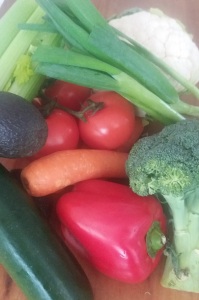A high intake of non-starchy vegetables in the diet is beneficial at so many levels. High in fibre, low in carbohydrates, packed with vitamins, minerals and phytonutrients, vegetables should form the largest part of our meals, covering at least half the plate at lunch and dinner and incorporating them into breakfast whenever possible. I think a future blog on veggie breakfast ideas is probably a good idea! It is a helpful to keep a large portion of our daily intake of vegetables raw, so we gain added benefits from the enzymes they contain. Opting to have salad at least once a day is a good start.
 However, if you have a copy of Erica White’s Beat Candida Cookbook, you will have read that some of us need to be careful with raw cabbage, since this contains goitrogens. If someone is suffering with an under active thyroid gland, the goitrogens in raw cabbage can inhibit the absorption of iodine, a mineral which is necessary for efficient thyroid activity. Because this vegetable is a cheap, year-round staple, it is easy to find that you are including raw cabbage regularly in the diet, making mayo-free coleslaw and European cabbage salad etc, and this may actually be unhelpful in your health journey. Simply blanching or lightly cooking the cabbage (and other goitrogen containing veg – see following) can break down the unhelpful compounds and make the goitrogen foods acceptable even for those with a struggling thyroid.
However, if you have a copy of Erica White’s Beat Candida Cookbook, you will have read that some of us need to be careful with raw cabbage, since this contains goitrogens. If someone is suffering with an under active thyroid gland, the goitrogens in raw cabbage can inhibit the absorption of iodine, a mineral which is necessary for efficient thyroid activity. Because this vegetable is a cheap, year-round staple, it is easy to find that you are including raw cabbage regularly in the diet, making mayo-free coleslaw and European cabbage salad etc, and this may actually be unhelpful in your health journey. Simply blanching or lightly cooking the cabbage (and other goitrogen containing veg – see following) can break down the unhelpful compounds and make the goitrogen foods acceptable even for those with a struggling thyroid.
LAURENTINE TEN BOSCH, at Food Matters has written a helpful article on the goitrogen foods
Goitrogen isn’t really a common word thrown around in the health industry.
But once you’ve found out that you have an issue with your thyroid, they’re typically something you hear of pretty quickly. But what are they and should you avoid them?
What Are Goitrogens?
Goitrogens are natural compounds found in certain foods that can interfere with your natural thyroid hormone production. This can lead to an enlargement of your thyroid gland, also known as a goiter.
What Do Goitrogens Do To Our Body?
The body’s metabolism and everyday functions are controlled largely by your thyroid. When your thyroid is healthy – they don’t do much at all. It’s only when your thyroid health is compromised. Goitrogens actually reduce the thyroid’s ability to produce the hormones your body uses to function normally by:
- Blocking iodine absorption into your thyroid,
- Interfering with a key enzyme that builds thyroid hormones,
- And reducing the amount of regulatory hormone that controls how much hormone your thyroid should make.
When your thyroid health is compromised, you can end up with difficulty controlling certain functions in your body, including:
- Body temperature
- Heart rate
- Calcium levels in your blood
- Protein production
- Absorption and utilisation of fats and carbohydrates that you eat
So if you have an autoimmune condition such as Hashimoto’s Disease, a goiter, or hypothyroidism, limiting your intake of goitrogens may be beneficial. But it’s highly unlikely that you will have to avoid them completely.
What Foods Contain Goitrogens?
The three main types of goitrogens – goitrins, thiocyanates, and flavanoids, are found in a variety of foods. The first two are released from the food when you eat them e.g. by slicing, chewing, or breaking down the food.
Goitrogen containing foods include:
- Cruciferous vegetables: broccoli, cabbage, Brussels sprouts, bok choy, cauliflower, spinach, kale, horseradish etc
- Fruits: peaches, pears, strawberries
- Starchy vegetables and plants: Sweet potato, cassava, bamboo shoots, millet, linseed
- Soy: tofu, tempeh, edamame, soy milk
Should You Avoid These Foods?
Not necessarily. If you have a healthy functioning thyroid, then you don’t need to limit your intake of goitrogen containing foods. But if you do have trouble with your thyroid or have symptoms outlined above, then it would be a good idea to reduce your intake of these foods, or try these tips to minimise their effects:
- Eat a variety of foods: Not only will this help you reduce your exposure, you’ll also get a variety of nutrients boosting your health overall!
- Heat and eat your vegetables: While a mix of healthy raw foods and cooked foods make for a good balance. When you roast, steam or saute your veggies instead of eating them raw, the enzyme myrosinase gets broken down which helps to reduce the goitrogenic load of the food.
- Blanch your greens: Yep, even if you want to add them to your smoothies – it’s best to lightly blanch them first to help break down the compounds. Don’t like it like that? Freeze it after you blanch so that it’s icy cold for your drink!
- Consume foods rich in iodine and selenium: These nutrients are amazing for thyroid health and can help counter the effects of goitrogens. Find iodine in kelp, seaweed, nori, iodised salt. Selenium can be found in brazil nuts, fish, meat, sunflower seeds, portobello mushrooms and whole grain pasta.
So unless you have serious issues with your thyroid already and have a super slow metabolism as a result of this, goitrogen-containing foods are actually a nutritious part of a healthy diet and should not be removed from your diet or restricted.